निलगिरी के लिए आलू का बीज उत्पादन करने की तकनीक
The potato crop produces more food (dry matter) than cereals and vegetables. It could be processed into a variety of products either by itself or in combination with other products. Due to these factors production and productivity level has shown a steady growth rate in the last four decades. Such a tremendous growth has been due to the agro-economic advantages of potato over other crops. Potatoes are traditionally propagated through vegetative means.
The Nilgiri hills, situated at an elevation of 1500 - 2600 meters above mean sea level at 11o 24’ North latitude and 74o 4’ East longitude is one of the oldest place where the potato crop was introduced by the foreign invaders long ago. Here, the potato crop can be cultivated through out the year due to its better geographical location making possible to receive rainfall evenly, round the year. The average annual rainfall of the region is 1400mm in about 100 rainy days and the mean maximum and temperatures are 22.2oC and 17.5oC respectively.
Potato production in Nilgiris
Nilgiris is a unique place of potato production where the cost of cultivation is very high when compared with that of the plains region. This is mainly because of high labour wages and two major plant protection problems viz., late blight and potato cyst nematodes. Here, the major share of cost goes towards the seed both during main as well as autumn seasons.
In the Nilgiris, potato can be grown through out the year under three distinct seasons namely, summer, autumn and winter. Summer is the main season (April/May to August/September) occupying around 3500 ha of potato area followed by Autumn (August/September to December/January) occupying 750 ha of the area. Potato crop is grown under rainfed conditions during both summer and autumn seasons. A meager area of about 100 ha is grown under irrigation during January/February to May/June as winter crop.
The seed requirement of Main crop is to be met from the autumn season harvest and for Autumn it is to be met from the Summer crop which has been planted little earlier than that of regular Summer crop i.e. during mid March as the irrigated crop is grown in a very negligible area.
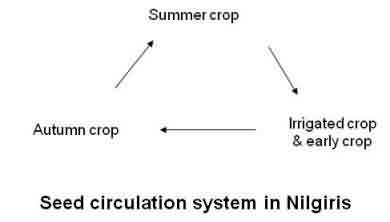
PROBLEMS
The major problems with respect to potato production in Nilgiris are
1.Non-availability of good quality seed :
As the farmers do not retain their own seed for next season planting, they depend mainly on out side source. The other important reason is that as the Autumn cultivation is in limited area, the arrivals of freshly harvested potatoes to the market are limited and this fetches more prices to the farmer if the produce is sold out. Hence, farmers tend to sell almost all the material with out keeping seeds for their own purpose. In addition most of the farmers being small and marginal they can not ear mark some space for storing the potato seed for the next season’s use.
Due to high cost involvement in quality seed production, the cost of the same would generally be higher. Hence, they resort to get seed from Mettupalayam market where the produce come from different places of peninsular India. By planting this seed there are chances of higher late blight infection which incurs more cost on plant protection in addition to reduced yields.
2. Late blight (Phytophthora infestans):
This is an important problem of potato seed production in the Nilgiris. The yield loss ranges between 20 – 50% depending upon its severity and adoption of control practices. For a normal seed production plot, to control late blight a prophylactic spray of systemic fungicide can be given as soon as the climate becomes <20oC temperature and >90% Relative humidity followed by contact fungicidal spray (Mancozeb 75% wp @ 2.5 kg/ ha-1 ) at 7 days interval from the initial appearance of the disease. The lower surfaces of the foliage are to be covered with fungicidal spray. In case of severe infection, the systemic fungicide spray can given. In general, 3 sprays of systemic fungicide and 5-6 sprays of Mancozeb are recommended, depending upon the weather conditions. But, as the farmers are using the seeds from general market, for which there is no assurance of quality, the disease incidence would be more, which warrants more number of sprays at double the rate of recommended dose to control it. This finally leads to increased cost of production as well as reduced yields.
If the quality seed is used from an assured source, then it is possible to reduce these number of sprays to recommended level and the produce will be free from tuber borne infections in addition to improvement in yield level.
3. Potato cyst nematodes (Globodera pallida and Globodera rostochiensis) :
This is a peculiar pest of Nilgiris and not seen in any other part of India. Affected plants get stunted with dull and unhealthy foliage and have a tendency to wilt during hot period of the day. In case of heavy infestation plants die prematurely. Chemical control is done by application of Furadon 3G @ 62.5 kg ha-1 as basal dressing at the time of planting. Cultural control is by
- Use of resistant cultivar like Kufri Swarna and K. Giriraj which limits the growth of nematode populations along with nematicide application
- Following crop rotation with crops like cabbage, carrot, radish and wheat
- Use of quality seed from recognized sources
REMEDIES :
Regularizing the seed circulation system : For most of the potato production problems, non-utilization of good quality is the root cause. This can be over come by adopting the regularized seed circulation system as mentioned else where, i.e., demarking a small area for early Summer crop which can be used as seed for Autumn season by force sprouting through chemical treatment using Carbon-di-sulphide. The Autumn harvested material can be used for irrigated crop by adopting artificial dormancy breaking and as such for Main (Summer) season.
Normally the harvested tubers require 2 – 3 months time for breaking their dormancy and to start sprouting. As the early harvested potato would be having dormancy, it has to be treated with chemicals to break the dormancy artificially. Treating the seed tubers with carbon–di–sulphide (@ 30ml quintal-1) can break the dormancy within 12-15 days of the treatment depending upon the variety.
Artificial dormancy breaking in potato
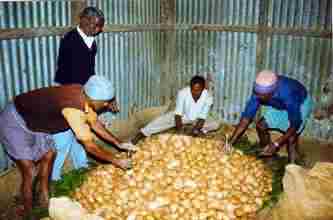
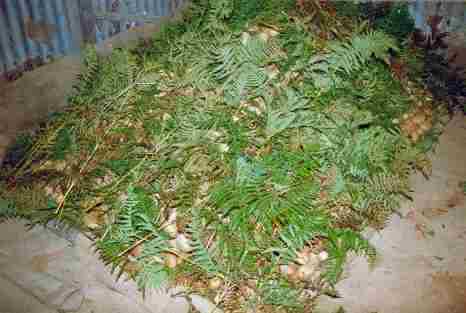
Placing the carbon-di-sulphide inside potato seed heaps and Placing kotagiri leaf over the seed heaps after keeping the carbon-di-sulphide
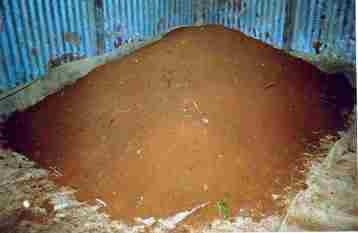 Covering the treated potato seeds with soil
Covering the treated potato seeds with soil
Farmers can maintain their own source of seed by adopting the above procedure. However, they need to change their seed once in 3-4 years from an authorized source in order to avoid degeneration.
Adoption of recommended package of practices for seed production : The practice of seed production differs from that of ware crop as more care needs to be taken to maintain its quality. Well sprouted, seed sized (50 – 60g for Summer and 30-40 g for Autumn)
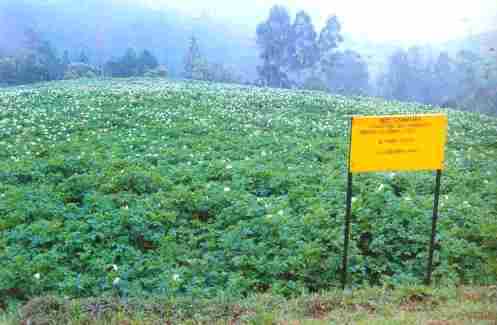 Seed crop at CPRS, Muthorai farm
Seed crop at CPRS, Muthorai farm
tubers of suitable variety can be planted at 50 x 15 cm, with a recommended dose of fertilizers (90 : 135 :90 kg NPK ha-1). Care has to taken for proper plant protection. Rogueing should be done 3-4 times to remove off types and rogue. Haulm killing should be done 10-15 days before harvesting. Haulm killing can be done either by manual by using sickle or by weedicide spraying (Gramoxone @2.5lit ha –1). The harvesting can be done manually with kothu (a small fork like instrument). Care should be given not to damage the skin and avoid the cutting of tubers. Store the seeds in well-ventilated, dark place preferably on racks. Lindane dust may be applied to avoid the superficial infections.
Future strategies for seed production in Nilgiris:
- Encouraging the farmers to use their own produce as seeds
- Strategies to use the main crop seed to use in the next main crop
- Educating the farmers about the proper use of plant protection measures
Authors:
*G.Ravichandran , R.Muthuraj and K.Manorama
*SENIOR SCIENTIST,
DOPR, Pedavegi , West Godavari, Andhra Pradesh
*email:
